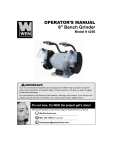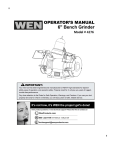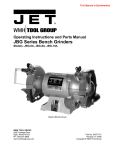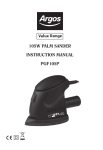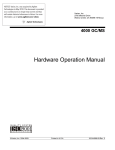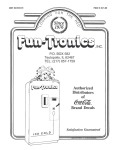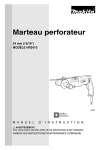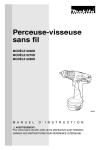Download Manual - Proxxon Tools
Transcript
ProxxonTools.com /E W D-54 518 L 2 5 20 1 0/6 V n 00 0 ~ H m W z ax a = tt 13 .0 0/m in N r. : 58 0 0-0 20 3 LW/E Manual 3080767 Conforms to ANSI/UL 60745-1 ANSI/UL 745-1 ANSI/UL 745-2-3 Certified to CAN/CSA-C22.2 No. 60745-1-04 CAN/CSA-C22.2 No. 745-1 CAN/CSA-C22.2 No. 745-2-3 h Nier sbac -2- 5 4 2 .: 58 Nr 3 -020 00 in /m .00 22 /600 W = 13 50 10 max n D -5 45 18 N ie rs ba ch /E LW 0 V~ Hzatt 3 7 6 1 Fig. 1 1 5 2 3 2 3 4 4 Fig. 2 1 Fig. 3 -3- PROXXON – LW/E Dear Customer, Before putting the machine into operation, read the enclosed safety rules and operating instructions. GENERAL SAFETY RULES Warning! Read and understand all instructions. Failure to follow all instructions listed below, may result in electric shock, fire and/or serious personal injury. SAVE THESE INSTRUCTIONS Work Area Keep your work area clean and well lit. Cluttered benches and dark areas invite accidents. Do not operate power tools in explosive atmospheres, such as in the presence of flammable liquids, gases, or dust. Power tools create sparks which may ignite the dust or fumes. Keep bystanders, children, and visitors away while operating a power tool. Distractions can cause you to lose control. Electrical Safety Double Insulated tools are equipped with a polarized plug (one blade is wider than the other.) This plug will fit in a polarized outlet only one way. If the plug does not fit fully in the outlet, reverse the plug. If it still does not fit, contact a qualified electrician to install a polarized outlet. Do not change the plug in any way. Double Insulation eliminates the need for the three wire grounded power cord and grounded power supply system. Avoid body contact with grounded surfaces such as pipes, radiators, ranges and refrigerators. There is an increased risk of electric shock if your body is grounded. Do not expose power tools to rain or wet conditions. Water entering a power tool will increase the risk of electric shock. Do not abuse the cord. Never use the cord to carry the tools or pull the plug from an outlet. Keep cord away from heat, oil, sharp edges or moving parts. Replace damaged cords immediately. Damaged cords increase the risk of electric shock. When operating a power tool outside, use an outdoor extension cord marked "W-A" or "W." These cords are rated for outdoor use and reduce the risk of electric shock. Personal Safety Stay alert, watch what you are doing and use common sense when operating a power tool. Do not use tool while tired or under the influence of drugs, alcohol, or medication. A moment of inattention while operating power tools may result in serious personal injury. -4- Dress properly. Do not wear loose clothing or jewelry. Contain long hair. Keep your hair, clothing, and gloves away from moving parts. Loose clothes, jewelry, or long hair can be caught in moving parts. Avoid accidental starting. Be sure switch is off before plugging in. Carrying tools with your finger on the switch or plugging in tools that have the switch on invites accidents. Remove adjusting keys or wrenches before turning the tool on. A wrench or a key that is left attached to a rotating part of the tool may result in personal injury. Do not overreach. Keep proper footing and balance at all times. Proper footing and balance enables better control of the tool in unexpected situations. Use safety equipment. Always wear eye protection. Dust mask, non-skid safety shoes, hard hat, or hearing protection must be used for appropriate conditions. Tool Use and Care Use clamps or other practical way to secure and support the workpiece to a stable platform. Holding the work by hand or against your body is unstable and may lead to loss of control. Do not force tool. Use the correct tool for your application. The correct tool will do the job better and safer at the rate for which it is designed. Do not use tool if switch does not turn it on or off. Any tool that cannot be controlled with the switch is dangerous and must be repaired. Disconnect the plug from the power source before making any adjustments, changing accessories, or storing the tool. Such preventive safety measures reduce the risk of starting the tool accidentally. Store idle tools out of reach of children and other untrained persons. Tools are dangerous in the hands of untrained users. Maintain tools with care. Keep cutting tools sharp and clean. Properly maintained tools, with sharp cutting edges are less likely to bind and are easier to control. Check for misalignment or binding of moving parts, breakage of parts, and any other condition that may affect the tools operation. If damaged, have the tool serviced before using. Many accidents are caused by poorly maintained tools. Use only accessories that are recommended by the manufacturer for your model. Accessories that may be suitable for one tool, may become hazardous when used on another tool. SERVICE Tool service must be performed only by qualified repair personnel. Service or maintenance performed by unqualified personnel could result in a risk of injury. When servicing a tool, use only identical replacement parts. Follow instructions in the Maintenance section of this manual. Use of unauthorized parts or failure to follow Maintenance Instructions may create a risk of electric shock or injury. Certain cleaning agents such as gasoline, carbon tetrachloride, ammonia etc. may damage plastic parts. SPECIFIC SAFETY RULES Accessories must be rated for at least the speed recommended on the tool warning label. Wheels and other accessories running over rated speed can fly apart and cause injury. Always use proper guard with grinding wheel. A guard protects operator from broken wheel fragments Hold tool by insulated gripping surfaces when performing an operation where the cutting tool may contact hidden wiring or its own cord. Contact with a „live“ wire will make exposed metal parts of the tool „live“ and shock the operator. If cutting into existing walls or other blind areas where electrical wiring may exist is unavoidable, disconnect all fuses or circuit breakers feeding this worksite. Always disconnect the power cord from the power source before making any adjustments or attaching any accessories. You may unexpectedly cause tool to start leading to serious personal injury. Be aware of the switch location, when placing the tool down or when picking the tool up. You may accidentally activate the switch. Always wear safety goggles and dust mask. Use the tool only in ventilated area. Using personal safety devices and working in safe environment reduces risk of injury. After changing the attachment or making any adjustments, make sure the collet nut and any other adjustment devices are securely tightened. Loose adjustment device can unexpectedly shift, causing loss of control, loose rotating components will be violently thrown. Do not reach in the area of the rotating wheel. The proximity of the rotating wheel to your hand may not always be obvious. Carefully handle both the tool and individual grinding wheels to avoid chipping or tracking. Install a new wheel if tool is dropped while grinding. Do not use a wheel that may be damaged. Fragments from a wheel that bursts during operation will fly away at great velocity possibly striking you or bystanders. Use clamps to support workpiece whenever practical. Never hold a small workpiece in one hand and the tool in the other hand while in use. Allow for sufficient space between your hand and the spinning bit. Round material such as dowel rods, pipes or tubing have a tendency to roll while being cut, and may cause the bit to „bite“ or jump toward you. Clamping a small workpiece allows you to use both hands to control the tool. Inspect your workpiece before cutting. When cutting irregularly shaped workpieces, plan your work so it will not slip and pinch the bit and be torn from your hand. For example, if carving wood, make sure there are no nails or foreign objects in the workpiece. Nails or foreign objects can cause the bit to jump. Never start the tool when the bit is engaged in the material. The bit cutting edge may grab the material causing loss of control of the cutter. Avoid bouncing and snagging the wheel, especially when working corners, sharp edges etc. This can cause loss of control and kick-back. If the workpiece or bit becomes jammed or bogged down, turn the tool off by the switch. Wait for all moving parts to stop and unplug the tool, then work to free the jammed material. If the switch of the tool is left on, the tool could restart unexpectedly causing serious personal injury. Do not leave a running tool unattended, turn power off. Only when tool comes to a complete stop it is safe to put it down. Do not grind or sand near flammable materials. Sparks from the wheel could ignite these materials. Regularly clean the tool’s air vents by compressed air. Excessive accumulation of powdered metal inside the motor housing may cause electrical failures. Do not alter or misuse tool. Any alteration or modification is a misuse and may result in serious personal injury. This product is not intended for use as a dental drill or in medical applications. Serious personal injury may result. -5- RÈGLES DE SÉCURITÉ GÉNÉRALES AVERTISSEMENT ! Vous devez lire et comprendre toutes les instructions. Le non-respect, même partiel, des instructions ci-après entraîne un risque de choc électrique, d’incendie et/ou de blessures graves. CONSERVEZ CES INSTRUCTIONS Aire de travail Veillez à ce que l’aire de travail soit propre et bien éclairée. Le désordre et le manque de lumière favorisent les accidents. N’utilisez pas d’outils électriques dans une atmosphère explosive, par exemple en présence de liquides, de gaz ou de poussières inflammables. Les outils électriques créent des étincelles qui pourraient enflammer les poussières ou les vapeurs. Tenez à distance les curieux, les enfants et les visiteurs pendant que vous travaillez avec un outil électrique. Ils pourraient vous distraire et vous faire faire une fausse manoeuvre. Sécurité électrique Les outils mis à la terre doivent être branchés dans une prise de courant correctement installée et mise à la terre conformément à tous les codes et règlements pertinents. Ne modifiez jamais la fiche de quelque façon que ce soit, par exemple en enlevant la broche de mise à la terre. N’utilisez pas d’adaptateur de fiche. Si vous n’êtes pas certain que la prise de courant est correctement mise à la terre, adressez-vous à un électricien qualifié. En cas de défaillance ou de défectuosité électrique de l’outil, une mise à la terre offre un trajet de faible résistance à l’électricité qui autrement risquerait de traverser l’utilisateur. Les outils à double isolation sont équipés d’une fiche polarisée (une des lames est plus large que l’autre), qui ne peut se brancher que d’une seule façon dans une prise polarisée. Si la fiche n’entre pas parfaitement dans la prise, inversez sa position ; si elle n’entre toujours pas bien, demandez à un électricien qualifié d’installer une prise de courant polarisée. Ne modifiez pas la fiche de l’outil. La double isolation élimine le besoin d’un cordon d’alimentation à trois fils avec mise à la terre ainsi que d’une prise de courant mise à la terre. Évitez tout contact corporel avec des surfaces mises à la terre (tuyauterie, radiateurs, cuisinières, réfrigérateurs, etc.). Le risque de choc électrique est plus grand si votre corps est en contact avec la terre. N’exposez pas les outils électriques à la pluie ou à l’eau. La présence d’eau dans un outil électrique augmente le risque de choc électrique. Ne maltraitez pas le cordon. Ne transportez pas l’outil par son cordon et ne débranchez pas la fiche en tirant sur le cordon. N’exposez pas le cordon à la chaleur, à des huiles, à des arêtes vives ou à des pièces en mouvement. Remplacez immédiatement un cordon endommagé. Un cordon endommagé augmente le risque de choc électrique. -6- Lorsque vous utilisez un outil électrique à l’extérieur, employez un prolongateur pour l’extérieur marqué “W-A” ou “W”. Ces cordons sont faits pour être utilisés à l’extérieur et réduisent le risque de choc électrique. Sécurité des personnes Restez alerte, concentrez-vous sur votre travail et faites preuve de jugement. N’utilisez pas un outil électrique si vous êtes fatigué ou sous l’influence de drogues, d’alcool ou de médicaments. Un instant d’inattention suffit pour entraîner des blessures graves. Habillez-vous convenablement. Ne portez ni vêtements flottants ni bijoux. Confinez les cheveux longs. N’approchez jamais les cheveux, les vêtements ou les gants des pièces en mouvement. Des vêtements flottants, des bijoux ou des cheveux longs risquent d’être happés par des pièces en mouvement. Méfiez-vous d’un démarrage accidentel. Avant de brancher l’outil, assurez-vous que son interrupteur est sur ARR T. Le fait de transporter un outil avec le doigt sur la détente ou de brancher un outil dont l’interrupteur est en position MARCHE peut mener tout droit à un accident. Enlevez les clés de réglage ou de serrage avant de démarrer l’outil. Une clé laissée dans une pièce tournante de l’outil peut provoquer des blessures. Ne vous penchez pas trop en avant. Maintenez un bon appui et restez en équilibre en tout temps. Un bonne stabilité vous permet de mieux réagir à une situation inattendue. Utilisez des accessoires de sécurité. Portez toujours des lunettes ou une visière. Selon les conditions, portez aussi un masque antipoussière, des bottes de sécurité antidérapantes, un casque protecteur et/ou un appareil antibruit. Utilisation et entretien des outils Immobilisez le matériau sur une surface stable au moyen de brides ou de toute autre façon adéquate. Le fait de tenir la pièce avec la main ou contre votre corps offre une stabilité insuffisante et peut amener un dérapage de l’outil. Ne forcez pas l’outil. Utilisez l’outil approprié à la tâche. L’outil correct fonctionne mieux et de façon plus sécuritaire. Respectez aussi la vitesse de travail qui lui est propre. N’utilisez pas un outil si son interrupteur est bloqué. Un outil que vous ne pouvez pas commander par son interrupteur est dangereux et doit être réparé. Débranchez la fiche de l’outil avant d’effectuer un réglage, de changer d’accessoire ou de ranger l’outil. De telles mesures préventives de sécurité réduisent le risque de démarrage accidentel de l’outil. Rangez les outils hors de la portée des enfants et d’autres personnes inexpérimentées. Les outils sont dangereux dans les mains d’utilisateurs novices. Prenez soin de bien entretenir les outils. Les outils de coupe doivent être toujours bien affûtés et propres. Des outils bien entretenus, dont les arêtes sont bien tranchantes, sont moins susceptibles de coincer et plus faciles à diriger. Soyez attentif à tout désalignement ou coincement des pièces en mouvement, à tout bris ou à toute autre condition préjudiciable au bon fonctionnement de l’outil. Si vous constatez qu’un outil est endommagé, faites-le réparer avant de vous en servir. De nombreux accidents sont causés par des outils en mauvais état. N’utilisez que des accessoires que le fabricant recommande pour votre modèle d’outil. Certains accessoires peuvent convenir à un outil, mais être dangereux avec un autre. RÉPARATION La réparation des outils électriques doit être confiée à un réparateur qualifié. L’entretien ou la réparation d’un outil électrique par un amateur peut avoir des conséquences graves. Pour la réparation d’un outil, n’employez que des pièces de rechange d’origine. Suivez les directives données à la section * Réparation + de ce manuel. L’emploi de pièces non autorisées ou le non-respect des instructions d’entretien peut créer un risque de choc électrique ou de blessures. RÈGLES DE SÉCURITÉ SUPPLÉMENTAIRES: Utilisez toujours un protecteur de meule approprié. Le protecteur arrête les éclats en cas de bris de la meule. Les accessoires doivent être prévus pour au moins la vitesse recommandée sur l’étiquette de mise en garde de le l’outil. Les meules et autres accessoires, s’ils tournent au-delà de la vitesse nominale, risquent d’éclater et de provoquer des blessures. Tenez l’outil par ses surfaces de prise isolées pendant toute opération ou l’outil de coupe pourrait venir en contact avec un câblage dissimulé ou avec son propre cordon. En cas de contact avec un conducteur sous tension, les pièces métalliques à découvert de l’outil transmettraient un choc électrique à l’utilisateur. -7- Symbols Important: Some of the following symbols may be used on your tool. Please study them and learn their meaning. Proper interpretation of these symbols will allow you to operate the tool better and safer. Symbol V A Hz W kg min s Ø n0 …/min 1, 2, 3, … ➞ Name Designation/Explanation Volts Amperes Hertz Watt Kilograms Minutes Seconds Diameter No load speed Revolutions or reciprocation per minute Selector settings Infinitely variable selector Arrow Alternating current Class II construction Voltage (potential) Current Frequency (cycles per second) Power Weight Time Time Size of drill bits, grinding wheels, etc. Rotational speed, at no load Revolutions, strokes, surface speed, orbits etc. per minute Speed, torque or position settings. Higher number means greater speed Speed is increasing from narrow end Action in the direction of arrow Type or a characteristic of current Designates Double Insulated Construction tools. Legend 1. 2. 3. 4. 5. 6. 7. Locking button Speed contol button ON-OFF switch Hoop Connection cable with mains plug Protective guard Grinding disc Noise level may exceed 85 dB(A) during operation. Ear protection must be worn! Vibration at handle ≤ 2.5 m/s2 Class II Equipment Double Insulation Operation: Replacing the Grinding Disc Functional Description Warning! The PROXXON Longneck Angle Grinder LW/E is the ideal device for model making, tool making and mould making and is also suitable, for example, for vehicle repairs. It can be used for deburring, roughing, fine grinding, chamfering, paint removal, rust removal, cutting small components and sharpening tools. It can be used on steel, non-ferrous metals, glass, wood and ceramics. Flat gearhead manufactured from die cast aluminium. Electronics for grinding speed control. Technical Data Motor: Voltage Power Unit: Rotational speed rpm Disc diameter Length Weight Characteristic noise emission -8- Disconnect the plug from the mains before replacing the grinding disc. The grinding disc diameter must not exceed the specified size of 2’’(50mm). Never press the locking button if the grinding disc is still rotating. 1. Press the locking button 1 (Fig. 2). 2. Turn the fastening screw 4 using an Allen key 5 until the locking button engages. 3. Undo the fastening screw 4, remove the centring disc 3 and the grinding disc 2. 4. Fit a new grinding disc. Ensure the grinding disc is properly seated in the centring disc shoulder. 5. Press the locking button 1 and tighten the fastening screw 4. 115 V~ hp (100 Watt) Adjust the protective guard. 3300 up to 13000 Disconnect the plug from the mains before the following. 1. Release fastening screw 1 (Fig. 3) and turn the protective guard to the desired position. 2. Retighten the fastening screw. Ensure the grinding disc is properly seated in the centring disc shoulder. 1/ 8 approx. 2’’(50 mm) 11 13/32’’ (290 mm) approx. 1,54 lb (700 g) ≤ 78 dB (A) Warning! Accessories Using the unit Warning! Injury hazard! Do not work without a dust protection mask and protective goggles. Do not use the unit on materials which contain asbestos. 1. Switch the unit on via the switch 3 (Fig. 1). 2. Use button 3 to set the unit speed to a speed appropriate for the work to be performed. Note! Do not press too hard when using the grinder. Good grinding performance can only be achieved using the correct and constant rotational speed. To achieve the best results when roughening, apply the grinding disc to the grinding surface at an angle of between 30° and 40° and move evenly back and forth over the workpiece. Do not bend the grinding disc into the cutting surface during cutting work. Warning! If the unit overheats, switch it off and allow it to cool. Accessories available from PROXXON The following table shows you the recommended speed for different accessories, supplied for your LW/E: Carborundum grinding disc 28585 (60 grit) 28586 (36 grit) Recommended 13.000 rpm 13.000 rpm Silicon Carbide grinding disc 28587 (60grit) 10.000 rpm Fan sander 28590 (100 grit) 28591 (150 grit) Corborundum bound cutting disc 28154 12.000-15.000 rpm 10.000 rpm Warning! Do not use the cutting disc for roughening work. Risk of fracture! Maintenance : Warning! Disconnect the plug from the mains before performing any maintenance or cleaning work. After use Clean the unit thoroughly, removing all grinding dust with a brush or a soft cloth. Ensure all ventilation slots are free from obstruction. The power cord shall be replaces by part no. 38544-32 only, if the cord is damaged. -9-










